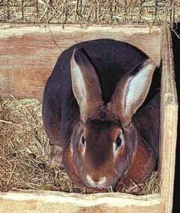Difference between revisions of "Fur rabbit"
Jump to navigation
Jump to search
(username removed) |
|||
| (2 intermediate revisions by 2 users not shown) | |||
| Line 2: | Line 2: | ||
== Description == | == Description == | ||
| − | The soft, velvety fur of the Castor Rex rabbit (Oryclolagus cuniculus). Most rabbits have long, coarse, flattened guard hairs which protect the fine undercoat hairs. The fur is thick and soft, but the skin is weak so the hides are usually sheared to produce [ | + | The soft, velvety fur of the Castor Rex rabbit (Oryclolagus cuniculus). Most rabbits have long, coarse, flattened guard hairs which protect the fine undercoat hairs. The fur is thick and soft, but the skin is weak so the hides are usually sheared to produce [[rabbit hair]]. The Castor Rex rabbit does not have guard hairs, only the thick underfur. Since at least 1919, it has been bred for its skin. Rabbit fur is used for linings and inexpensive garments. It is often marketed as northern seal. Most rabbit fur is obtained from Europe, Asia, New Zealand and Australia. |
== Synonyms and Related Terms == | == Synonyms and Related Terms == | ||
| Line 8: | Line 8: | ||
Castor Rex (''Oryclolagus cuniculus''); pelo de castor (Esp.); peau de lapin (Fr.); konijnenbont (Ned); northern seal; | Castor Rex (''Oryclolagus cuniculus''); pelo de castor (Esp.); peau de lapin (Fr.); konijnenbont (Ned); northern seal; | ||
| − | == | + | ==Physical and Chemical Properties== |
Color = gray, white, brown or black | Color = gray, white, brown or black | ||
| − | == | + | ==Resources and Citations== |
* Edward Reich, Carlton J. Siegler, ''Consumer Goods: How to Know and Use Them'', American Book Company, New York City, 1937 | * Edward Reich, Carlton J. Siegler, ''Consumer Goods: How to Know and Use Them'', American Book Company, New York City, 1937 | ||
| − | * | + | * Konenhagen Fur at http://www.kopenhagenfur.com/sw13434.asp |
* ''Van Nostrand's Scientific Encyclopedia'', Douglas M. Considine (ed.), Van Nostrand Reinhold, New York, 1976 | * ''Van Nostrand's Scientific Encyclopedia'', Douglas M. Considine (ed.), Van Nostrand Reinhold, New York, 1976 | ||
Latest revision as of 13:49, 26 August 2022
Description
The soft, velvety fur of the Castor Rex rabbit (Oryclolagus cuniculus). Most rabbits have long, coarse, flattened guard hairs which protect the fine undercoat hairs. The fur is thick and soft, but the skin is weak so the hides are usually sheared to produce Rabbit hair. The Castor Rex rabbit does not have guard hairs, only the thick underfur. Since at least 1919, it has been bred for its skin. Rabbit fur is used for linings and inexpensive garments. It is often marketed as northern seal. Most rabbit fur is obtained from Europe, Asia, New Zealand and Australia.
Synonyms and Related Terms
Castor Rex (Oryclolagus cuniculus); pelo de castor (Esp.); peau de lapin (Fr.); konijnenbont (Ned); northern seal;
Physical and Chemical Properties
Color = gray, white, brown or black
Resources and Citations
- Edward Reich, Carlton J. Siegler, Consumer Goods: How to Know and Use Them, American Book Company, New York City, 1937
- Konenhagen Fur at http://www.kopenhagenfur.com/sw13434.asp
- Van Nostrand's Scientific Encyclopedia, Douglas M. Considine (ed.), Van Nostrand Reinhold, New York, 1976
- The American Heritage Dictionary or Encarta, via Microsoft Bookshelf 98, Microsoft Corp., 1998
